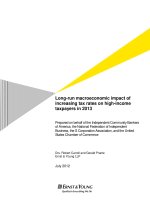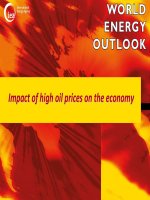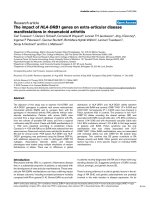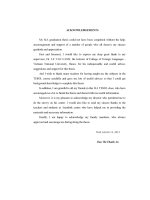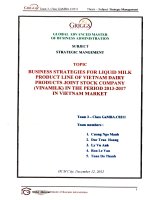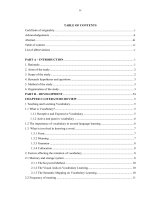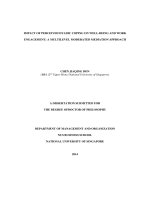The impact of international oil prices on the industrial production index in vietnam
Bạn đang xem bản rút gọn của tài liệu. Xem và tải ngay bản đầy đủ của tài liệu tại đây (946.78 KB, 58 trang )
UNIVERSITY OF ECONOMICS
HO CHI MINH CITY
VIETNAM
INSTITUTE OF SOCIAL STUDIES
THE HAGUE
THE NETHERLANDS
VIETNAM – NETHERLANDS
PROGRAMME FOR M.A IN DEVELOPMENT ECONOMICS
THE IMPACT OF INTERNATIONAL OIL
PRICES ON THE INDUSTRIAL PRODUCTION
INDEX IN VIETNAM
BY
NGUYEN THI HAU
MASTER OF ARTS IN DEVELOPMENT ECONOMICS
HO CHI MINH CITY, NOVEMBER 2013
The impact of international oil prices on industrial production index in Vietnam
Nguyen Thi Hau_MDE16
UNIVERSITY OF ECONOMICS
HO CHI MINH CITY
VIETNAM
INSTITUTE OF SOCIAL STUDIES
THE HAGUE
THE NETHERLANDS
VIETNAM – NETHERLANDS
PROGRAMME FOR M.A IN DEVELOPMENT ECONOMICS
THE IMPACT OF INTERNATIONAL OIL
PRICES ON THE INDUSTRIAL PRODUCTION
INDEX IN VIETNAM
A thesis submitted in partial fulfillment of the requirements for the degree of
MASTER OF ARTS IN DEVELOPMENT ECONOMICS
By
NGUYEN THI HAU
Academic Supervisor:
Dr. CAO HAO THI
HO CHI MINH CITY, NOVEMBER 2013
2
The impact of international oil prices on industrial production index in Vietnam
Nguyen Thi Hau_MDE16
ACKNOWLEDGEMENT
This thesis could not completed without considerable and kindly mental supports
from my supervisor, Dr. Cao Hao Thi, who spend his valuable time to help me to
find materials, books and super my schedule tightly. He also responses quickly as
soon as I ask for help and give comments, which partly contribute to the success of
this thesis. From bottom of my heart, I sincerely thank him for all.
This study also benefits greatly from the enthusiastic assistance of Dr. Truong Dang
Thuy, whom I got knowledge on econometric and suggest the suitable models for
the study.
I would like to express my thanks for all students of MDE 16 for their unceasing
assistance and encouragement and show deep gratitude to the lectures, VNP staffs,
and library staffs for their helps in accumulating knowledge, accessing dataset and
materials as well.
Last but not least, it gives my deepest grateful to my family members, husband,
manager and colleagues for their dear encouragement, give favorable times and
opportunities to finish the M.A course as well as the thesis.
I pledge to bear full responsibilities for errors, omissions and shortcomings of the
study.
3
The impact of international oil prices on industrial production index in Vietnam
Nguyen Thi Hau_MDE16
ABSTRACT
This thesis focus on analyzing the impact of oil prices on the industrial production
index in Vietnam. Beside the impact of international oil prices, the paper also uses
other variables such as real money supply, real exchange rate and structural break in
order to find out the relationship between these variables and industrial production
index. The data of those variables is monthly data, from January 1999 to December
2011. Regarding the methodology, the linear regression model and error correction
model suggested to apply for balanced data set. The test results show that oil prices
fluctuation have positive impact on the economic activities throughout the industrial
production index in the long run. Based on that, the Vietnamese economy can
adjust itself to adapt with the fluctuation of the international oil prices in the long
run. In contrast, real money supply and real exchange rate have negative impact on
the industrial production index. Additionally, the economy is divided by two
periods: before and after financial crisis that is represented by dummy variable.
However, this division cannot explain the economic activities. In the short-run,
there is only real money supply could be the adjusted parameter for changing of
industrial production index.
4
The impact of international oil prices on industrial production index in Vietnam
Nguyen Thi Hau_MDE16
TABLE OF CONTENTS
ACKNOWLEDGEMENT ..........................................................................................3
ABSTRACT ................................................................................................................4
TABLE OF CONTENTS ............................................................................................5
LIST OF FIGURES.....................................................................................................7
ABBREVIATIONS.....................................................................................................9
CHAPTER 1: INTRODUCTION .............................................................................10
1.1.
Problem Statement ..........................................................................................10
1.2.
Objectives of study .........................................................................................13
1.3.
Research questions ..........................................................................................13
1.4.
Scope of the research ......................................................................................14
1.5.
Structure of the thesis......................................................................................14
CHAPTER 2: THEORETICAL AND EMPIRICAL BACKGROUND .................15
2.1.
Theoretical background ..................................................................................15
2.2.
Empirical review .............................................................................................18
2.3.
The conceptual framework .............................................................................21
2.4.
Variables .........................................................................................................22
2.4.1. Dependent variable ......................................................................................22
2.4.2. Explanatory variables ..................................................................................24
CHAPTER 3: RESEARCH METHODOLOGY .....................................................31
3.1.
Research process .............................................................................................31
3.2.
Model establishment .......................................................................................31
3.3.
Data .................................................................................................................34
3.4.
Unit root test ...................................................................................................35
3.5.
Cointegration test ............................................................................................35
CHAPTER 4: DATA ANALYSIS ..........................................................................37
4.1.
Industrial production and oil prices ................................................................37
4.2.
Descriptive analysis ........................................................................................39
4.3.
Linear regression model ..................................................................................40
4.4.
Augmented – Dickey Fuller (ADF) Test ........................................................41
5
The impact of international oil prices on industrial production index in Vietnam
Nguyen Thi Hau_MDE16
4.5.
Optimal lag length ...........................................................................................41
4.6.
Cointegration test ............................................................................................42
4.7.
Error Correction Model (ECM) ......................................................................42
CHAPTER 5: CONCLUSION AND POLICY IMPLICATIONS ..........................44
5.1.
Conclusion ......................................................................................................44
5.2.
Policy implications..........................................................................................45
REFERENCES ..........................................................................................................47
APPENDIX ...............................................................................................................52
ESTIMATED RESULTS ..........................................................................................53
6
The impact of international oil prices on industrial production index in Vietnam
Nguyen Thi Hau_MDE16
LIST OF FIGURES
Figure 2.1. The relationship between increasing in oil prices and the
19
economy recessions
Figure 2.2. The conceptual framework between variables
22
Figure 2.3. Economic development and energy trend in Vietnam
24
Figure 3.1. The research process
31
Figure 4.1. The trend of development of industrial production and oil
36
price in Vietnam
Figure 4.2. The trend of development of real exchange rate in Vietnam
37
Figure 4.3. The trend of development of real money suppy in Vietnam
37
7
The impact of international oil prices on industrial production index in Vietnam
Nguyen Thi Hau_MDE16
LIST OF TABLES
Table 2.1. Summary of variables
28
Table 4.1. Summary Statistic on the sample observations
38
Table 4.2. Correlation on the sample observations
38
8
The impact of international oil prices on industrial production index in Vietnam
Nguyen Thi Hau_MDE16
ABBREVIATIONS
GDP:
Gross Domestic Products
GNP:
Gross National Products
CPI:
Consumer Price Index
VAR:
Vector Autoregression
ECM:
Error Correction Model
IPI:
Industrial Production Index
OIL:
Oil price
RM:
Real Money Supply
REER:
Real Effective Exchange Rate
IMF:
International Monetary Fund
ADB:
Asian Development Bank
9
The impact of international oil prices on industrial production index in Vietnam
Nguyen Thi Hau_MDE16
CHAPTER 1: INTRODUCTION
1.1.
Problem Statement
It cannot be deniable the important role of the energy resource with the human life.
All economic activities from the smallest unit such as household to the heavy
industry use power everyday and the demand for it increasing day by day and one
of the most important among the energy resource is oil. In the current economic
context with strong level of development, oil is a very important resource for
production and has the significant effect to the economic growth.
The world has seen the fluctuation of oil prices over the periods and confirmed that
oil prices changes have strongly impact on the macroeconomic activities throughout
the industrial production index. The inflation and recession matters all over the
world have related to oil prices changes. The increase in oil prices in 1973-1974
and again in 1979 made the mass in the world economy. At that time, the prices
rose significantly because of strongly shortage in oil supply and high inflation
expanded to other industries that made the slowdown in the economy. Recent rising
of oil prices is also a reason that makes the economist worry about the prospect of
the international finance. Additionally, the scarce of natural resource, the current
reserve of oil and some conflict about oil in the Middle East are the major problems
for the economic activities. According to OPEC report (OPEC annual statistic
bulletin, 2010-2011), more than three-quarters of the world's proven oil reserves are
located in OPEC Member Countries, with the bulk of OPEC oil reserves in the
Middle East, accounting for 70% of the OPEC total and OPEC's proven oil reserves
currently stand at well above 1000 billion barrels (accounting for 79.6%). While the
oil reserves of non-OPEC countries is about 20.41% (about 272.9 billion barrels).
With the increasing continuously of exploiting and using oil, the scarce of oil
resource cannot be avoidable and the oil prices hardly to fall, which have negative
effect on the economic activities, in which the heavy industry is affected as well.
There are many researches about the relationship between oil prices changes and
industrial production index. Firstly, oil prices fluctuations impact not only on the
10
The impact of international oil prices on industrial production index in Vietnam
Nguyen Thi Hau_MDE16
demand channel but also on the supply channel of industry. The supply- side effects
are related to the fact that crude oil is the input for the production. If there was an
increasing in oil prices, the cost of production would be increasing as well,
especially in industrial zones. The oil prices also affect to the consumption and
investment. Consumption is affected indirectly to through its positive relationship
between oil prices and disposable income. The consuming power will be declined if
the oil prices rise significantly. Furthermore, investment decisions are related to the
changes of oil prices because of the increasing in the firms’ production cost.
Secondly, theory economic suggest that stock prices reflect expectations about the
future firm’s earnings. Firm’s profit is a mainly part of GDP and its components
such as consumption and investment; therefore, when the firms have difficulties
with high production cost due to high oil prices, the profit probably fall down lead
to the decreasing in the present value of expected stock dividend while expected
stock dividend must ultimately reflect the real economic activities. In general, the
empirical researches on many countries in the world have showed that oil prices and
industrial production index have the negative relationship. Based on the result
which is found out from the mentioned researches, this thesis is investigating the
relationship between the oil prices and industrial production index in Vietnam and
answer the question that whether the relationship between oil prices and industrial
production index in Vietnam is negative or not.
In this paper, analyzing the impact of oil prices on the industrial production index in
Vietnam is the main point. Vietnam is a country, which has been criticized for its
heavy reliance on export of crude oil. According to the Vietnam’s oil statistics,
Vietnam has an estimated 2,300 million tons of oil reserve. Vietnam exports about
16-18 million metric tons of crude oil per year, accounting for almost 20 percent of
export earnings. This number contribution to GDP stands at about 18-20 percent
and about 25-30 percent of government revenues per year. However, the problem
for Vietnamese economy is that Vietnam export crude oil to the outside with the
low price but it has to import petroleum products from the other countries with
11
The impact of international oil prices on industrial production index in Vietnam
Nguyen Thi Hau_MDE16
higher price. Therefore, when an oil crisis happened, Vietnam would suffer a huge
damage because the price of output lead to the increasing in input production cost in
industrial zones and other sectors in domestic market.
In addition, base on the data regarding the oil consumption from Vietnam’ oil
statistics, the consumption of oil in Vietnam is about over 331,000 barrels per day
and it is forecasted to keep increasing to 5-7 percent per annum in the end of 2014.
However, the current statement of Vietnam’s oil reserves is not good. Vietnam
opened its first oil refinery plant in quarter 1 in 2009 – Dung Quat refinery and its
capacity is at least 140,000 barrels per day of locally produce and imported crude,
producing diesel, gasoline, jet fuel, etc. This plant is just satisfied only about onethird of Vietnam’s fuel demand lead to the import petroleum products is still a big
problem. Additionally, Bach Ho oil field is expected to be closed in 2020. If there
are no new sources are found, Vietnam will run out of oil and gas resources by
2025.
In the beginning of 2011, the world oil price increases quickly that make the
domestic firms have to face with the difficulties in rising in production cost, some
companies cannot afford to run the business and have to bankruptcy announce.
From that statement, Vietnam is country that has been potentially vulnerable to oil
price volatility. The Vietnamese Government (i.e. the Ministry of Industry and
Trade) has applied many methods to resolve the increasing in oil price in order to
prevent the Vietnamese economy from the world crisis. In practically, the oil price
is controlled by the Government; therefore, regardless of changing of world oil
price, the oil price in Vietnam is quite stable. However, although the price is under
controlled, the Government still suffers the pressure from the oil companies. A
specific example is the continuously movement of gas price, the price increases
from 2011 until now. Along with the increasing of oil and gas, the consumer price
index also increases and other bad effects, which make the economy, become a
mass.
12
The impact of international oil prices on industrial production index in Vietnam
Nguyen Thi Hau_MDE16
Throughout analyzing the impact of international oil prices on the industrial
production index, the thesis could predict the development trend of the part of the
economy. Because the
definition of economic activities is quite “broad”, in
accordance with the research of Yin-Wong Chung and Lilian K. Ng (1997)
mentioned to the macro variables which are proxies for the measures of aggregate
economic activities include the real gross national product (GNP), real money
supply and real consumption. Additionally, Shahid Ahmed (2008) in his research
regarding aggregate economic variables and stock markets in India also referred to
the key macro variables which are representing for economic activities such as
index of industrial production, exports, foreign direct investment, money supply,
exchange rate, interest rate and some other variables. Base on that, the scope of this
research cannot cover all the above macro variables; therefore, this thesis is just
focus on analyzing the impact of oil prices on the industrial production index and
recommending some solutions for the oil price in the future.
1.2.
Objectives of study
The goal of the thesis is to clarify the impact of international oil prices on the
industrial production index in Vietnam. Specific objectives include:
[1]
Investigate the impact of oil prices fluctuation on the industrial production
index in short-run and long run;
[2]
Recommend the solution for the economy in order to resolve the current
difficulties and find out the policy for the long-term stable development.
1.3.
Research questions
To obtain the above objectives, this thesis will attempt to answer the following
questions:
[1]
Do the international oil prices affect to the industrial production index in
the long-run or in the short-run?
[2]
Based on the analysis of oil price impact on the industrial production
index, what will be the proper solutions for the economy?
13
The impact of international oil prices on industrial production index in Vietnam
Nguyen Thi Hau_MDE16
1.4.
Scope of the research
The research is focus on analyzing the impact of oil price on the industrial
production index in Vietnam. The data is monthly data, from January 1999 to
December 2011 (156 observations). In this research, the industrial production index
is used as dependent variable.
1.5.
Structure of the thesis
The research consists of five chapters as followings:
Chapter 1 explains reason why the topic of thesis is chosen, significance of the
thesis, main objectives, some major research questions and the scope of the
research.
Chapter 2 provides an overview on theoretical background of the impacts of oil
prices on the industrial production index.
Chapter 3 highlights the research methodology. This chapter also describes the
general econometrics model as well as variables and data and outlines the process to
analyze data.
Chapter 4 shows the statistic results from adopted models. Findings are analyzed
and to make clear in reaching objectives and answering the questions in Chapter 1.
Results of empirical studies by other researchers are also used to strongly support
our findings.
Chapter 5 resumes main findings and recommends useful policies for Vietnam in
strategy of economic growth harmony with environment protection. This chapter
also identifies the limitation and implications for further study.
14
The impact of international oil prices on industrial production index in Vietnam
Nguyen Thi Hau_MDE16
CHAPTER 2: THEORETICAL AND EMPIRICAL BACKGROUND
This chapter provides an overview about the definition of the factors in the topic
such as oil prices, and industrial production index. In addition, the empirical
reviews have been presented in order to capture the research results of many authors
all over the world. Furthermore, throughout the empirical study, a conceptual
framework is presented and the variables of the model are defined respectively.
2.1.
Theoretical background
Definition of the oil prices
Oil is an international commodity that every country has to use for production and
for daily consumption. No country can effectively isolate itself from changes of
world oil prices and be affected by the increasing or decreasing of prices and it is
linked to all the level of economic activities. Therefore, paying attention to the oil
prices volatile become the premier conditions for production firms, in specific and
for the whole economy in general. Oil prices have been variables since the large
price increases of the 1970s and 1980s. The wide price fluctuations in 2007 and in
early 2008 reinforce the idea that oil prices are volatile. A numerous research
mentioned about the impact of the fluctuation of oil prices on the macro economy
all over the world, mainly in United States and in OECD countries (Hamilton 1983,
1996, 2005, 2009, Barsky and Killian 2004, etc.). Numerous researchers suggest
that oil price fluctuations have considerable consequences for real economic activity
and the oil price volatility also effect on both demand-side and supply-side of the
economy. In accordance with Robert Kaufmann and Brenda Kuhl, economic
activities are often measured by macro variables such as Gross National Product or
Gross Domestic Product. Additionally, as mentioned in the Introduction part, there
are some other macro variables used for representing for the economic activities
including industrial production index.
15
The impact of international oil prices on industrial production index in Vietnam
Nguyen Thi Hau_MDE16
Definition of the industrial production index
Industrial production index is an index which details the growth of various sector in
an economy. Industrial production index is an abstract number, its magnitude
represents for the status of production in the industrial sector for a given period of
time as compared to a reference of time.
The Department of Economic and Social Affairs (2010) defines the industrial
production index as a factor describes the change of the volume of goods or services
produced over times. This indicator is very important for assessing the performance
of an economy and a key input for calculating volume measures as part of the
compilation of the national accounts. In respect of the relationship between
economic activities and industrial production index, some authors used the
industrial production index proxy for the economic activities when analyzing the
effect of oil prices on the whole economy. For instance, Lee and Ni (2002) have
found that oil prices shock act mainly as supply shocks for oil-intensive industries,
such as petroleum refineries, and act mainly as demand shocks for many other
industries. Additionally, there are some researches about the impact of oil price
shocks at the industry level such as Bohi (1989), Kilian and Park (2007).
The impact of oil price fluctuation on the industrial production index
In the research of Robert Barsky and Lutz Kilian (2004), they divided the timing of
oil prices shocks into three periods. The first period was falling in 1970s, which
shows its important role to recognize the impact of oil fluctuation on the macro
economy. The second stage was notably in the 1986 which see the decreasing in oil
prices and the 2000 is the boom of oil prices. The oil crisis had been continuing
increasing in the 1990-1991 Gulf war and the 2003 Iraq war. According to
Hamilton (1983), oil price increases seem to be one of the main causes of recessions
in USA prior to 1972. Within a vector autoregression (VAR) framework, Hamilton
has found a strong causal and negative correlation between oil price change and real
U.S. GNP growth from 1948 to 1980. In accordance with Hamilton (1983), the
recessions in USD prior to 1972 is mainly caused by the increasing of oil prices.
16
The impact of international oil prices on industrial production index in Vietnam
Nguyen Thi Hau_MDE16
Using the method of vector autoregression (VAR), the strong relationship between
oil prices and U.S. GNP growth is found out from 1948 and 1980. Accordingly, oil
prices and U.S. GNP growth has the causal relationship and negative correlation,
therefore, the oil shocks did not have much effect to the real incomes for the
economy. Additionally, the results from Blanchard and Galí’s research (2007)
indicated that the increasing in oil prices have the negative effects to the
development of the economy in the early 2000s with the bloom oil. Accordingly,
Emre C. Alper and Orhan Torul (2008) unveiled that the negative impact of oil
price changes on the aggregate economic activities is still significant even after
2000.
The analyzing of oil prices impact not only in one country but also in many
countries in the world. Each of country is different from nature of economy, natural
resources and other characteristics, however, the researchers have showed a general
point is that increasing in oil prices has negative impact on the economic activities
throughout the national index such as GDP, CPI, consumption, stock prices, etc.
There are many researchers from various countries like Mork et al. (1994),
Valadkhani et al (2001), Papapetrou (2004), Naveed Iqbal Syed (2010). Mork et al
(1994) studied about the oil price, GDP relationship in seven OECD countries. In
this paper, he showed the correlation between oil price movement and GDP
fluctuations for seven OECD (United States, Canada, Japan, Germany (West),
France, the United Kingdom and Norway). Valadkhani et al (2001) took the
example of Australia to assess the impact of oil price changes on consumer goods
and services during year 1971-2009 and he saw that when the oil prices increased,
the price of related goods and services followed to rise; high inflation and the
economic growth fell down. Similarly, Naveed Iqbal Syed (2010) studied the case
in Pakistan and Papapetrou (2004) analyzed the case in Greece. Additionally,
Huang et al (2005) examined the effect of oil price change and its volatility on
economic activities in the United States, Canada and Japan. Their findings reveal
that when oil price change and volatility exceed a threshold, the relationship
17
The impact of international oil prices on industrial production index in Vietnam
Nguyen Thi Hau_MDE16
between oil prices changes and industrial production along with stock market
returns will be explained strongly.
Emre C. Alper and Orhan Torul (2008) investigated the effects of oil prices changes
on the real output for a net oil importing small open economy, Turkey. Accordingly,
this study used a structural VAR approach with the monthly data from 1991 to 2007
in order to analyze the impact of oil prices on the economic activities in Turkey.
And the findings is that the economy has the negative response to the increasing in
oil prices and the fluctuation of oil prices is an important issue for a small open
economy such as Turkey.
François Lescaroux and Valérie Mignon (2008) in their own research showed the
links between oil prices and various macroeconomic and financial variables for a
large set of countries. The independent variables they used to analyze are GDP,
CPI, household consumption, unemployment rate and share prices. These indicators
represent for the movement of the economy. The research results have proved the
relationship between oil price fluctuation and the economic activities is negative
when the oil price increases day by day in short-run and long run.
Xiufang Wang (2010) used the monthly time series from 1992:2 to 2008:8 and the
methods of VAR model and variance decomposition analysis to investigate the
dynamic relationship among the real economic activities, stock prices and oil prices
in three countries (i.e. Russia, China and Japan). His findings showed that three
variables have the long-run stationary relationship and the variables have the same
trend of development during the sample period. In addition, throughout the method
of variance decomposition analysis, the stock prices shocks and oil prices shocks
have the impact on the real economic activity. In particular, the results present 4.7%
of the variability is explained by the oil shocks and the economy is very sensitive to
the changes of in world oil prices. However, the percentage of sensitive in the shortrun is not as higher as the long-run.
2.2.
Empirical review
18
The impact of international oil prices on industrial production index in Vietnam
Nguyen Thi Hau_MDE16
Ramón Cobo-Reyes et. Al in their research in 2005 regarding the effect of oil prices
on industrial production and on stock returns and collected data from January 1963
to May 2004. The model is suggested by Hamilton (1989) in order to analyze the
relationship between the variables. They depicted the impact of oil prices
fluctuation on the industrial production in the Figure 2.1.
Figure 2.1. The relationship between increasing in oil prices and the economy
recessions.
The results of the research indicate that oil prices and industrial production and
stock market have the negative relationship, means that when the oil prices increase,
then the industrial production will be decrease respectively. Furthermore, after
immediate shocking period, increasing in oil prices lead to the three times higher of
the stock returns changes compare with the changes of industrial production.
Nevertheless, four periods after the shift, the order is changed, in particular, the
response of industrial production will be two times higher than the response of the
19
The impact of international oil prices on industrial production index in Vietnam
Nguyen Thi Hau_MDE16
stock returns before the fluctuation of the oil prices. Based on that, the reaction of
the stock prices will be faster than the response of the industrial production in the
short time, but in the long time, the reaction of industrial production will be higher.
In 2006, Komain Jiranyakul studied about the impact of international oil prices on
industrial production in Thailand using Johansen cointegration test. The author also
used the industrial production index to measure the development trend of the
economy. And the results have showed that the industrial production index will not
be affected by the changing of U.S dollar real exchange rate. However, the oil
prices and the real money supply have positive impact on the industrial production
index. It means that when the oil prices increase, the manufacturing sector can
adjust itself to higher costs of production in the long run. In the short run, industrial
production is affected by real money supply, real exchange rate and international oil
prices. However, any deviation from a stationary long-run equilibrium in the short
run will be corrected in a short period. The authors find the method to find out the
long-run relationship between oil prices, inflation, exchange rate and economic
activities. Based on the results, the oil prices and the real effective exchange rate
have the significant impact on economic activities. Furthermore, an increasing in oil
prices or depreciation may enhance economic activities and the negative
relationship between oil prices and economic activities is proved through their
analysis.
Komain Jiranyakul in the research which was published on the Munich Personal
RePEc Archive in December 2006 has analyzed the impact of international oil
prices on Thailand’s industrial production. Accordingly, he found that the
manufacturing sector can adjust itself to higher cost of production in long run
throughout the positive relationship between industrial production index and oil
prices. In addition, he put some other variables such as US dollar real exchange rate
and real money supply into the model and the result is that these two variables have
the significant effect to the industrial production index respectively. By using firstly
the linear regression equation, the research has analyzed the relationship between
20
The impact of international oil prices on industrial production index in Vietnam
Nguyen Thi Hau_MDE16
dependant variable and independent with the data collection from January 1990 to
December 2004. With this model, Komain used the dummy variable in order to
capture the impact of financial crisis and the dummy variable takes the value of zero
before the financial crisis from January 1990 to July 1997, and of one thereafter.
Secondly, for determining whether existence a long-run relationship between the
variables or not, the Error Correction Model (ECM) has been applied. The result of
this study present that the oil prices fluctuations have the negative impact on the
industrial production index and the negative relationship could be observed in the
short run. In the long run, due to an upward trend of oil prices, the Thai economy
can be adjusted itself to higher cost of production.
In addition, Surender Kumar has showed his result regarding the macroeconomic
effects of oil prices shocks in India on the Economic Bulletin, which was, published
on 4th February 2009 by means of multivariate Vector Autoregression Model using
both linear and non-linear specifications. This research analyses the impact of oil
price shocks on industrial production growth for the case of Indian economy for the
period from Quarter I of the year 1975 to Quarter III of the year 2004. The results
show that the oil prices shocks have the negative impact on the industrial
production development, in particular, when the oil prices increase one hundred
percent, then, the industrial production index will be decrease by one percent.
In this research, I would like to base on the research of Komain Jiranyakul in order
to develop the idea of international oil prices fluctuation on the Vietnamese
economic activities. I also used both linear regression equation and the ECM to
analyze the relationship between economic activities and oil prices. However, the
period is covered from January 1999 to December 2011 and focus on the
Vietnamese case, therefore, there are some significant different from the empirical
study.
2.3.
The conceptual framework
Based on the previous research, the linear regression model and ECM are applied in
order to present the relationship between oil prices and industrial production index
21
The impact of international oil prices on industrial production index in Vietnam
Nguyen Thi Hau_MDE16
in this paper. Moreover, the variable of Real Exchange Rate (RX) will be included
in the model. In addition, this paper also uses the dummy variable (D) to avoid the
structural break in the data. The reason of choosing these variables will be further
explained in the next part.
The impact of the above variables of the research is shown in conceptual framework
in Figure 2.2.
Figure 2.2. The conceptual framework
Oil prices
Linear regression
equation and ECM
Industrial production
index
Real Exchange Rate
Real Money Supply
Structural break (Dummy variable)
2.4.
Variables
2.4.1. Dependent variable
Many studies have researched to measure the relationship between the oil prices and
industrial production index. Accordingly, IPI can be used to proxy for the output of
the whole economy. They are Komain Jiranyakul (2006), Surender Kumar (2009),
Huson Joher Ali Ahmed, Omar H.M.N. Bashar, I.K.M. Mokhtarul Wadud (2012),
Le Viet Trung, Nguyen Thi Thuy Vinh (2011). In this study, the industrial
production index is chosen as the dependant variable for some following reasons:
22
The impact of international oil prices on industrial production index in Vietnam
Nguyen Thi Hau_MDE16
Firstly, (the Department of Economic and Social Affairs – Statistics Division, 2010)
defined the industrial production index as following: “The industrial production
index measures volume changes in the production of an economy, and therefore
provides a measurement that is free of influences of price changes, making it an
indicator of choice for many applications. While being an important indicator in its
own right, the index of industrial production also plays an important role in the
national accounts since it reflects the temporal changes in the value added for
individual industries, as well as having a strong relationship with the performance
of the economy as a whole. For this reason, in many research, the authors used the
industrial production index in order to estimate the change of economic activities in
the relationship with the other variables”.
Secondly, industry is the area that is using the largest oil volume among others.
(The International Energy Outlook) said, “Energy is consumed in the industrial
sector by a diverse group of industries, including manufacturing, agriculture,
mining and construction and for a wide range of activities, such as processing and
assembly, space conditioning and lighting. The industrial sector consumed 52
percent of global delivered energy in 2008, and its energy consumption grows by an
average of 1.5 percent per year over the projection. Industrial energy demand
varies across regions and countries of the world, based on the level and mix of
economic activity and technological development, among other factors. Industrial
energy use also includes natural gas and petroleum products used as feedstock to
produce non-energy products, such as plastics and fertilizer”. For the case of
Vietnam, the economy has grown fast over recent years, energy demand has
expanded even faster than the economy, which is increased from 5.187 million toe
(tons oil equivalent) in 1990 to 13.128 million toe, indicating an average annual
growth rate of 12.3%. Additionally, during the 16 years from 1990, energy
consumption increased 5.8 times from 5.187 million toe to 30.026 million toe. In
1990, the industrial sector accounted for 36% of energy demand while the
transportation sector for 36% and other sectors for 28%. These shares changed to
23
The impact of international oil prices on industrial production index in Vietnam
Nguyen Thi Hau_MDE16
the respective levels of 47%, 30% and 23% in 2006. While the industrial sector’s
share of total energy demand expanded fast, the shares for the transportation and
other sectors shrank. Based on that, the fast energy demand expansion reflected the
industrial sector’s robust development and energy demand growth in the other
sectors was relatively slower. The development trend is depicted as the Figure 2.3.
Figure 2.3. Economic development and energy trend in Vietnam
2.4.2. Explanatory variables
Beside variable oil prices, which under the chosen models, some other explanatory
variables comprise in the research to explain more exogenous influence on the
industrial production index. They are real money supply, real exchange rate and the
dummy variable for structural break in data collection. The reasons for using these
variables are detailed as following:
Firstly, the oil prices may affect industrial production index indirectly through the
other important transmission channels, in part by inducing changes in economic
policies. Those channels include effects of oil prices on the money supply to the
economy and exchange rates, which then induce changes in real economic
activities.
24
The impact of international oil prices on industrial production index in Vietnam
Nguyen Thi Hau_MDE16
Secondly, using the multivariate modeling framework instead of bivariate one is to
avoid the case of omitting the variable bias. In addition, a lot of working research
regarding the impact of oil prices on the economic activities using the other
variables for analyzing.
Oil prices
The research is using the international oil prices instead of national oil prices. The
reason is that national oil prices have been influenced by price-controls, exchange
rate fluctuations and national price index variation. Therefore, most of the empirical
literature analyzing the effect of oil price on the economic activities that used the
world price of oil as a common indicator to measure the level of impact such as
Mork, Olsen Mysen, Hamilton, JC Nkomo, Hussain A. Bekhet, Nora Yusma
Mohamed Yusop, etc. (cited from Berkeley (2012) Energy prices and real economic
activity).
Many researchers, including Burbidge and Harrison 1984, Bernanke et al. 1997,
Hamilton 1983, Hamilton and Herrera 2001, Hamilton 2003, and Gisser and
Goodwin 1986 have the conclusion that the oil prices have the negative relationship
with the economic in United States. In particular, when the oil prices increase, then,
the economic in United State will be downturn. In addition, some other researches
for a lot of countries around the world have found out that there are strong
correlation or co-integration relationship between international oil prices and
macroeconomic variables in the long run. The authors are Boukez 2007, Jones et al
2004, Hamilton 2003, Rodrigues and Sanchez 2004; Davis et al 2005).
The main purpose of this research is analyzing the impact of oil prices on the
industrial production index. However, besides the effect of oil prices, the research
will include two other variables (i.e. real effective exchange rate and dummy
variable of financial crisis) to find out the impact of them on the economic
activities.
Real Money Supply (RM)
25

